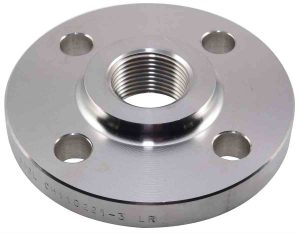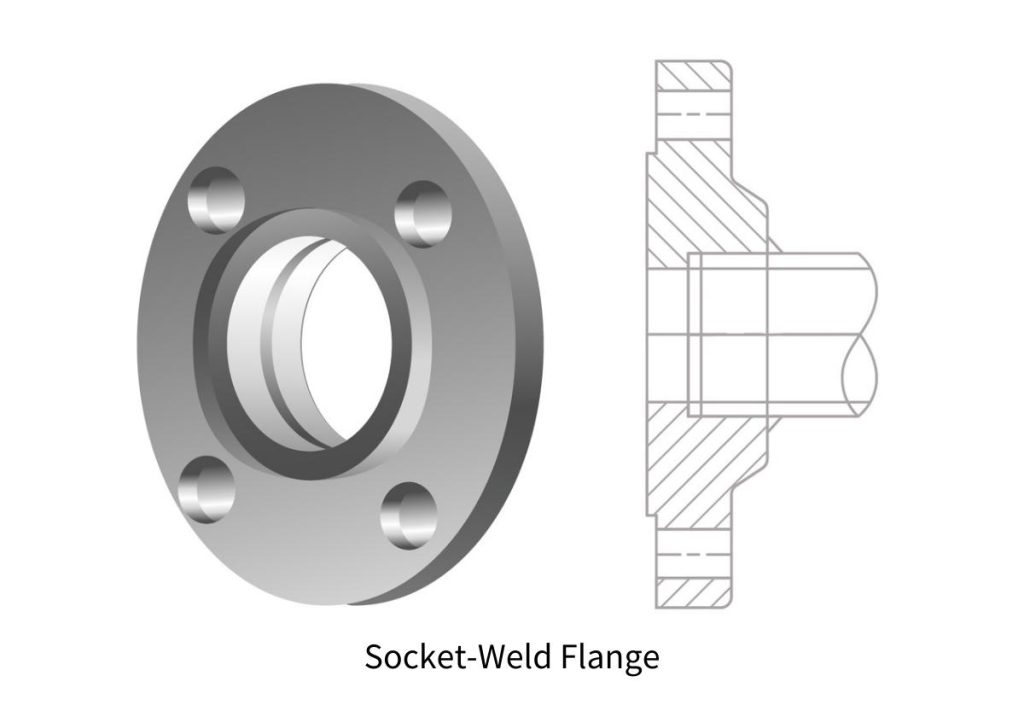Flange, its types and applications in different industries
Flanges are one of the most widely used high pressure connections in various industries. A piece that has circular or disc-like plates. Flanges are used to connect pipes, parts and valves in the way of transferring all kinds of fluids.
Structure and appearance
As mentioned, the flange is circular in shape. Flanged solid discs have multiple holes. The bolt connection happens through these holes. The material of the flange is steel, cast iron and other alloys. In addition to using welding to connect the two ends of the pipe,
The most practical way to connect in the piping route is to use a flange.
Advantages of flanges
In addition to bolting, flanges are also welded to the equipment. But the use of bolt and nut flanges, in addition to reducing costs, makes piping easier. The use of flanges can also simplify the maintenance of the fluid transfer path. Although welded connections may seem more secure, flanges also provide a secure and reliable connection.
How to connect all types of flanges
The flange has specific and fixed locations for bolts and nuts. To connect the flange in the piping route, first one side of the flange is welded to the pipe, valve or any desired piece. Then the two flange discs are placed against each other with all precision. After that, these two pieces are connected through bolts and nuts. There are different types and sizes of flanges. This issue makes these connections suitable for low and high pressures.

Gasket or flange seal
The flanges are connected to each other by means of bolts and nuts. The sealing between two flanges is done through the use of a gasket. The gasket is a piece that is placed between two flanges and prevents the leakage of piping fluids.
Other advantages of flange
In addition to ease of installation and increasing the speed of various projects, the flange has other advantages. These connections can be separated. The most basic way to connect two pipes during the transfer of fluids is to weld them. Now, if you need to separate them for any reason, you have to cut the pipes. This happens when using the flange. It means that when you use the flange to connect the pipe, it can be easily opened. Other advantages of using flanges include the following:
Changing the size of pipes manually
The possibility of changing the type and type of pipe after piping when using the flange
The possibility of connecting the pipe to all types of faucets
Types of flanges and their specifications
As mentioned earlier, flanges are produced in different dimensions, materials and pressure classes. In general, to buy a flange, we should pay attention to its specifications. These specifications are engraved on the body of the flange based on existing standards. The most important of these are:
Production number in order to know the time and series of production in the factory
Raw material standards
Basic materials
The size of the pipe that will be welded to the flange
The diameter of the holes and the thickness of its wall
Flange class and working pressure
Saze brand
Size and dimension standards
Dimensional characteristics
Flanges are made based on two standards ASMEB16.9 and ASMEB16.47. The most important dimensions of the flange are its height, pressure class, size and category.

Class
Flange pressure tolerance is called flange class. This value actually refers to the thickness of the bottom of the flange. Therefore, the higher the class value, the higher the pressure resistance of the flange. In standards, flanges are placed in classes 75, 150, 300, 600, 900, 1500, 2500. According to the API standard, flanges are produced in classes 2000, 3000, 5000, 10000 and 25000.
size
A number that actually specifies the outer diameter of the flange bottom. It means the opening and the place where fluids pass.
Category
The number that is different in this section in throated and silent welded flanges. In fact, the flange grade is engraved on it to determine the wall thickness and the inner diameter of the flange. This value should be equal to the pipe that is going to be connected to the flange. In the throat flange, this number represents the thickness of the wall edge and the inner diameter. This is while in the silent weld flange, it indicates its inner diameter. It is interesting to know that the number of the flange category does not apply to other types of flanges.
Flange application and target industries
As we mentioned before, flanges can be used in various industries, some of which we mention:
Flange suitable for nuclear facilities
Oil and gas industry flange
Flange for hospital equipment
Use in liquid transfer pipelines
Flange of fire extinguishers
Different methods of flange production
Flanges are produced and marketed in different ways:
metallic
forge
Casting

Metal flange
One of the methods of producing quality flanges is sheet metal turning. In this method, due to rolling in the production process of sheet metal, there are less cracks and porosity than cast flange. For this reason, they have better resistance than cast flanges. But this type of connections have less resistance compared to forged flanges. Among the flanges that are made in this way, the following can be mentioned:
racket (glasses)
blind
Flat PN or Spilon
tip!
Considering that it is not cost-effective to make a throat flange from sheet metal, if you see such flanges in the market, you should suspect that it is a waste. Therefore, it needs further investigation.
Forged flange
In fact, forged flanges are high pressure connections made through forging operations. This means that the raw material is placed in the forging mold and after the piece is beaten at a very high temperature, the overall shape of the flange is obtained. The forging operation, or the beating mentioned above, is done due to the improvement of the mechanical properties. This manufacturing method, which is based on ASTMA105 standards, puts the most resistant forged flange on the market. This piece is suitable for use in industries with very high temperature and pressure conditions.
Cast flange
Casting flange, also known as cast iron, is special for low temperature and pressure. As can be seen from the name of this type of flange, the molten material is poured into the flange molds and after turning, the final shape of the flange is made.
On the other hand, with this model, there is a risk of creating internal cracks, porosity and inhomogeneity of the internal metal structure of the cast piece. In this case, the use of casting flanges in industrial applications requiring high temperature pressure is not recommended at all.
tip!
The cast flange cannot be recognized after the turning operation, and it must be subjected to maltography test to find out this important.
Different flange surfaces
When choosing the most suitable piping flange, it is very important to pay attention to the shape of the flange surface. For this reason, in the following, you will get to know the different surface types of flange connections:
Smooth or raised?
flat
A flat surface flange has a flat and uniform surface that is connected to another flat flange with a washer. Flat face or flange flat face is another name for it.
Raised surface flange
It includes a prominent part in the forehead of the flange. The short name of this connection is RF. These circular protrusions cause the gasket to be in its best condition during connection, and the screws placed on the flanges do this well. The raised surfaces on this flange generally have grooves whose number and depth are based on the standard. For example, in the price of small face flange, the standard height in classes 300 and 150 is about 2 mm. In higher classes, this height reaches 7 mm.
Ring or grooved!?
Ring surface
They are used in processes with high temperature and pressure. These flanges have a groove along with a metal washer. The gasket used in the Junit ring flange is made of steel. This means that the material of the ring, which is placed in the groove of the ring flange, is softer than the material of the flange itself. Therefore, when two flanges are tightened and compressed by bolts, this steel rim loses its original state and takes the shape of a groove. In this way, metal-to-metal sealing occurs.
Grooved surface
Flange with regular and matching grooves for better alignment and easy connection. Male, female and grooved flanges are somehow necessary for each other. Because part of the protrusion on the flat surface of a flange is placed inside the grooves of the opposite flange. Therefore, such flanges must be prepared in pairs. Of course, these flanges are almost obsolete since they cannot be connected to other equipment.
Types of flanges
Slipon flange
blind flange
Lapjoint flange
Luriface flange
Welded throat flange
Welded globular flange
Welded silent flange
Threaded flange
Rocket flange/spectacle blinder
Slipon flange
It is one of the most widely used flanges. This flange is welded to the pipe. Therefore, it can be said that it is easy to install. The strength and resistance of the slipon flange against infiltration and pressure is lower than that of the throat flange.
Welded silent flange
Sukti-Joshi is one of the types of flanges. The basis of this flange is that it has a step in the fluid passage. This break divides the inner diameter of the flange into two parts. To connect, the pipe goes up to the step part of the flange and then it is welded from the outside.

blind flange
The blind flange is used to block the ends of the piping paths. This connection, like other flanges, is a disc-shaped round plate, which bears a different pressure than other flanges.
Threaded rib flange
This type of arc pressure connection has threads that are screwed into the pipe.
Lapjoint flange
This flange is used for bottom connections. The method of using the lap joint flange is that the pipe is welded to the end of the flange. In this case, this flange can rotate easily. This type of flange is used in routes that require frequent opening and closing.
Throat flange
Among the types of flanges, we can mention the throat flange. This type of connection has a conical neck.
Application in connections
So far, we have discussed the complete description of the types of flanges and the basis of work and the shape of this high pressure connection. Before the end, in this section, we will briefly review some applications of flange connection:
Change of material in piping
It makes it possible to connect pipes with pressure tanks and…
It is easily separated and solves the problem.
Buy a flange
Alborz Part Jahan company, with more than several years of experience as one of the strongest manufacturers of all kinds of high pressure fittings, sells flanges at factory prices and supplies without intermediaries. Therefore, if you intend to buy, you can make a phone call to the advisers of the collection and solve any of your needs and doubts in this regard.
Today’s price of flange
The price of flange depends on many factors such as material, type, size and size. Contact us for more information about the price of the day.
All rights of this website belong to Alborz Part Jahan company